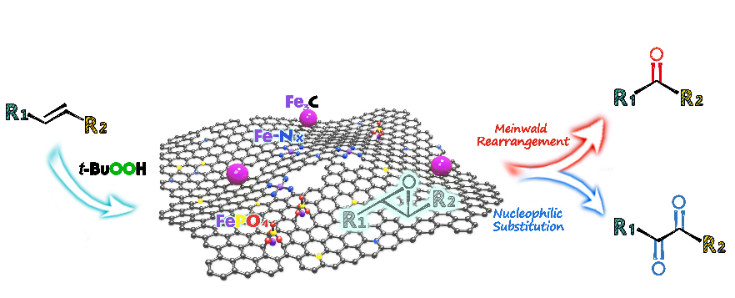Scientists Propose Novel Bifunctional Iron Nanocomposite Catalyst
Oxidation of alkenes to carbonyl compounds is one of the most important industrial reactions. The oxidation products are very important and useful intermediates or building block in synthetic organic chemistry, pharmaceuticals, agrochemicals, and bulk/fine chemicals.
Traditional synthetic methods always need harsh and environmental unfriendly conditions. Therefore, developing a green and efficient catalytic process is highly desirable.
Recently, a research team led by Prof. YANG Yong from Qingdao Institute of Bioenergy and Bioprocess Technology (QIBEBT), Chinese Academy of Sciences (CAS), reported the fabrication of a bifunctional iron nanocomposite catalyst, in which two catalytically active sites of oxidation and Lewis acid sites are simultaneously integrated into a porous carbon.
As a bifunctional catalyst, it exhibited high efficiency for direct oxidative cleavage of alkenes into ketones or their oxidation into 1,2-diketones with a broad substrate scope and high functional group tolerance in water under mild reaction conditions. Meanwhile, the catalyst is highly stable and can be recycled for several times.
This work not only opens up a fancy pathway in the rational design of Fe-N-C catalysts, but also offers a simple and efficient method for accessing industrially important ketones and 1,2-diketones from alkenes in a cost-effective and environmentally benign fashion.
The related progresses were published in ACS Catalysis. This work was supported by Key Technology R&D Program of Shandong Province and The Royal Society (UK) for a Newton Advanced Fellowship.

Fig 1. Synthesis of ketones and 1,2-diketones via oxidation of alkenes catalyzed by bifunctional iron nanocomposite catalyst (Image by SONG Tao)
(Text by SONG Tao)
Contact:
CHENG Jing
Qingdao Institute of Bioenergy and Bioprocess Technology, Chinese Academy of Sciences
Tel: 86-532-80662647/80662622
E-mail: chengjing@qibebt.ac.cn